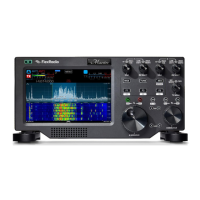FLEX-6000 Signature Series – Maestro User Guide
Copyright 2024 FlexRadio, Inc. All Rights Reserved. | Page 71
16 HOW TO USE PROFILES
Profiles allow the user to name and save the state of the radio and recall it later. Profiles can even
be exported and restored on another FLEX-6000 Series radio. This facilitates convenient backup of
radio configurations and also helps IT managers of DXpeditions or contest super-stations test
configurations and then install or restore them at a site. Individual operators can also save their
favorite settings and then, after others have operated, restore the state of the radio.
There are three types of profiles: GLOBAL, TRANSMIT, and MIC. Global profiles store the state of
the radio including the Panadapters and Slices that are open, the mode associated with each Slice,
and all of the settings for noise blankers, AGC, filters, etc. This can be thought of as a snapshot in
time. Transmit profiles save the transmitter power level, tune power level, transverter power level,
and the various transmitter delay parameters. MIC profiles save a configuration for a specific
microphone or audio source, including the TX filter settings, the MIC selection and level, and the
DEXP, PROC, DAX, VOX, and EQ settings. Both Transmit and MIC profiles are automatically saved
when the related controls are changed.
Profiles are far superior to traditional "band stacking" in that you can save as many different
configurations as desired and give them a meaningful name for recall.
16.1 MIC PROFILES
MIC profiles manage a set of radio parameters associated with microphones and other audio
sources. These include TX filter settings, MIC selection and level, and DEXP, PROC, DAX, and VOX
settings. A complete list of the parameters is provided in section 16.7, Comparing Profiles and
Persistence.
The MIC profile can be selected from the Profiles control panel in the Maestro Main Menu. Tap
the name of the desired profile, then tap the Load button. See section 16.4, Saving and Deleting
Profiles for more details about using the control panels.
MIC profiles can be associated with the mode of a Slice Receiver. The MIC profile in effect at any
point in time is determined by the mode of the transmit Slice, or by a Global profile. Two Slice
Receivers may exist, set to different modes, but only one controls the transmitter (for each
Station), the active Slice determines the MIC profile selection.
To associate a MIC profile with a mode, mode groups are used. LSB and USB are considered to be a
single mode group (SSB), as are DIGU and DIGL (Digital), FM, NFM, DFM (FM), and AM and SAM
(AM). RTTY and each Waveform installed in the radio are treated as a separate mode.
To associate or link a Mic profile to a particular mode group, set the transmit Slice to the mode you
wish to link, then load or save a Mic profile while the transmit Slice is in that mode. From then on,
whenever the transmit Slice is set to that mode the linked Mic profile will be loaded. For example:
Slice A – Mode is USB
Load Default FHM-1 Mic profile. (This Mic profile is now linked to the USB/LSB mode group)
Change Slice A to SAM (This loads the default linked MIC profile Default)
Load Default PR781 Mic profile. (This Mic profile is now linked to the AM/SAM mode
group)

